[vc_row themestek_responsive_css=”56037300|colbreak_no||-||-|||||colbreak_no|||||||||colbreak_no||||||||||colbreak_no|||||||||”][vc_column][vc_column_text css=”.vc_custom_1643306878892{margin-right: 20px !important;margin-left: 20px !important;border-right-width: 50px !important;border-left-width: 50px !important;}”]
Why Frameworks Matter
The IQ-EQ-BioQ framework is a conceptual map. It is a scheme to help orient you on the complex topic of intelligence based on the latest scientific research – and it may in itself help augment your intelligence over time by harnessing what is called the framing effect.
Frames are patterns of interpretation that are used to classify and process information. Framing has a selective function for our limited attentional resources: it emphasizes certain parameters of reality and pushes others into the background. As a large body of research has shown, in this way certain attributes, judgments, and decisions are primed and have a meaningful impact in how we navigate our cognitive worlds.
Framing is related to the well-established and powerful technique of cognitive reappraisal in clinical psychology, which is the reinterpretation of an emotion-eliciting situation in a way that alters its meaning and changes its emotional impact. Cognitive reappraisal is one of the key pillars of cognitive behavioral therapy (CBT) interventions.
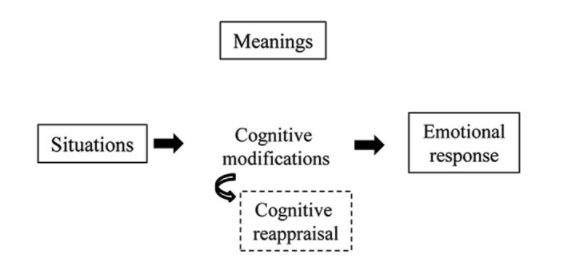
Tapping the framing effect by absorbing and reflecting on the concepts presented in the IQ-EQ-BioQ framework, you can conceptualize your cognition in new ways that over time can potentially augment your general intelligence. This concept-driven advantage is in addition to the effects of any actual brain training you do. Concepts matter. As the Thomas theorem states, if a situation is interpreted as real it is real in its consequences. Actions follow from your perceptions and interpretations, independently from your actual skills or knowledge of the way the world is in itself. A framework like this provides a map you can navigate with moving forward.
Definition of General Intelligence
Professor Robert Sternberg, the eminent psychologist and psychometrician who researches in the areas of creativity, intelligence, cognitive styles and love, has said:
Viewed narrowly, there seem to be almost as many definitions of intelligence as there were experts asked to define it.
For example, within the AI community that is populated with many robots, Lenat and Feigenbaum define it as:
the power to rapidly find an adequate solution in what appears a priori to be an immense search space.

But looking at the concept more broadly – and in human terms – we can readily find consensus definitions among experts in the field. Here are two well-known definitions:.
[the] ability to understand complex ideas, to adapt effectively to the environment, to learn from experience, to engage in various forms of reasoning, to overcome obstacles by taking thought.” American Psychological Association
And
“the ability to reason, plan, solve problems, think abstractly, comprehend complex ideas, learn quickly and learn from experience. It is not merely book learning, a narrow academic skill, or test-taking smarts. Rather, it reflects a broader and deeper capability for comprehending our surroundings —”catching on,” “making sense” of things, or “figuring out” what to do. Gottfredson & 52 intelligence researchers
IQ-EQ-BioQ Framework
The IQ-EQ-BioQ framework for understanding intelligence is faithful to these consensus definitions. According to this framework, general adaptive intelligence (G) is a set of interrelated capacities, skill, knowledge and strategies defined by three factors and their interactions: (1) IQ (fluid and crystallized intelligence – Gf and Gc), (2) emotional intelligence (EQ), and (3) biological intelligence (BioQ). These are supported by ‘intelligent designs’ that we are embedded in – our social networks, culture and technologies (Gx).
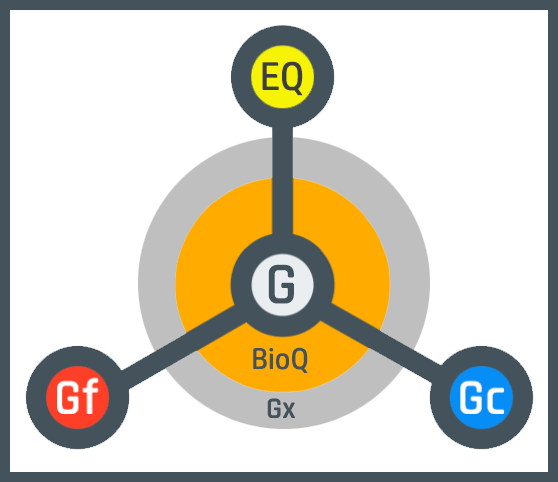
Let’s look at each of these dimensions of G in turn.
IQ – What You Know And Can Figure Out
IQ consists of two co-dependent factors: fluid intelligence (Gf) and crystallized intelligence (Gc).
Your fluid intelligence (Gf) is your inference & learning engine: your ability to efficiently comprehend, infer and validate relationships and rules, reach conclusions through reasoning, find solutions, and to learn in the process. Gf is exercised when you can’t rely on habit or automatic pilot mode, but you need goal-directed, ‘top down’ executive control. Gf-intensive information processing, puts high demands on your working memory and attention resources – called ‘cognitive load.’ Working memory (WM) is a limited capacity mental workspace, and using working memory depends on attention control – your ability to focus on what is relevant to your goals while shielding from distraction or inhibiting unwanted habits or responses.
A doctor uses fluid intelligence to figure out an unusual illness based on presented symptoms; an app developer uses Gf to write clean, efficient code for new applications and fix any bugs, an engineer uses Gf to figure out optimal solutions under well-defined constraints and resource limitations, while an athletic coach or CEO uses Gf to figure out the competition’s game-plan or the ‘mind games’ they may play, taking them into the realms of ‘theory of mind’ and ‘game theory.’
Your crystallized intelligence (Gc) is your skills, memories and knowledge that underpin your competences in everyday life, such as your language ability or general knowledge. If you think of fluid intelligence as being in the foreground of your thinking – under the spotlight – you see crystallized intelligence as the background stage – the scene, your persona and the narrative so far – Gc defines your life space, your umwelt – and your ability to act intuitively and by habit within it, as though on automatic pilot.
Over time, Gf is invested into the accumulation of Gc: it’s an unfolding, two-way relationship. As the IQ scholar Raymond Cattell Cattell put it:
this year’s crystallized ability level is a function of last year’s fluid ability level
There is a positive feedback loop at work here: with more crystallized intelligence capacity to apply your knowledge and skills, the more effectively your fluid intelligence can be deployed, which in turn accelerates your capacity to build knowledge.
General intelligence is the fluid ability to integrate multiple cognitive abilities in the service of solving a novel problem and thereby accumulating crystallized knowledge that, in turn, facilitates further [fluid ability]. ― WISC-V (Second Edition), 2019
Here is a video clip of the brilliant Sherlock Holmes (Benedict Cumberbatch, BBC One) applying both his fluid intelligence and his background crystallized intelligence by inferring this dramatic conclusion from just the numbers on his phone!
There’s a margin for error but I’m pretty sure there’s a Seven Forty-Seven leaving Heathrow tomorrow at six thirty in the evening for Baltimore. Apparently it’s going to save the world. Not sure how that can be true but give me a moment; I’ve only been on the case for eight seconds.
Together, fluid (Gf) and crystallized intelligence (Gc) are measured as the g factor by classic tests of IQ, such as the WISC-V and WAIS-IV, as well as other standardized (bell-curved)assessments of cognitive ability, such as the General Intelligence Assessment (GIA) – used in corporate recruiting. Psychometric g is the factor that underlies the positive correlations between all fluid and crystallized intelligence tests).
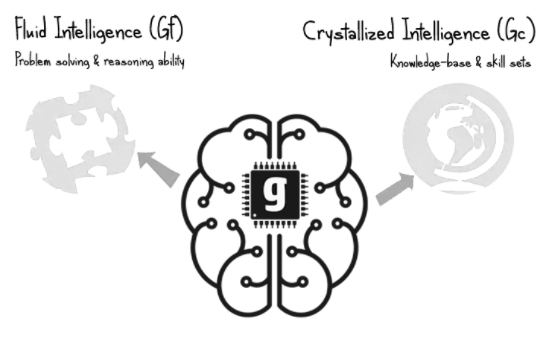
See Appendix 1 below for some fluid and crystallized intelligence test problems.
EQ – Your Ability to Evaluate, Self-Regulate & Find Fulfillment
Traditional psychometric IQ tests do not measure your ability to make rational decisions based on utility or personal preference, or self-regulate adaptively in a challenging and often stressful environment. This is because IQ is concerned with your reasoning, comprehension and knowledge – not with your ability to take action to fulfill your needs and desires in accordance with your preferences, values and beliefs. But this is certainly critical to rationality – and rationality is integral to general intelligence that concerns our ability to “adapt effectively to the environment.”
This blindspot in psychometric conceptions of intelligence as simply the g factor has stimulated what is called the ‘great rationality debate,’ and has led notable scholars in cognitive science to propose additional dimensions of intelligence – such as Stanovich’s ‘reflective’ level in addition to the ‘algorithmic’ level of cognitive ability, and in Sternberg’s triarchic theory both ‘practical’ intelligence and ‘analytic’ intelligence. More generally, it has led to a tremendous interest over recent decades in the idea of emotional intelligence – the ability to perceive and manage emotions – and its potential for improving our resilience and performance.
The EQ part of the IQ-EQ-BioQ framework understands your emotional intelligence as the ability to adapt and attune yourself to your overall environment in a way that is rational and rewarding long-term. It requires an ability to evaluate, prioritize and make decisions for action, based on expected incentives, rewards and punishments that are experienced as emotions and states of arousal. EQ adds an action-oriented dimension to fluid intelligence. It enables reinforcement learning through the experience of incentives, and underlies our personal goals, motivations and desires based on this learning. Through your EQ you become conscious of threats, opportunities, mistakes and unexpected experiences or outcomes – popping you out of the automatic and habit-based Gc mode into the ‘meta-cognitive’ where you can monitor, regulate, reflect, plan and explore. Here you can prioritize and focus your attention, often tapping executive control and fluid reasoning in the process. Let’s say you are a Bitcoin trader and have strongly expected your investments to keep growing, but…there has just been a devastating crash in the market! When you saw the charts it made your heart race, and your analytic mind went on overdrive to figure out the cause and recover the situation. In this way EQ can be seen as an interface between your crystallized and fluid intelligence.
EQ enables us to experience the world through the medium of feeling – both through internal interoception like feeling excited, tired or anxious, and emotional expression and communication – to better self-regulate, adapt and attune ourselves to the situations we are in. Without these abilities, we might find ourselves forever calculating or stuck in our habits and instinctive responses, without evaluating and committing to effective action in an appropriate state of mind – such as being excited, motivated and focused in committing to a new life-changing career move. Or using executive control to manage the impressions that we make in social situations – such as we see in the movie ‘Inside Out’ in this EQ-demanding scene! The first couple of minutes give you the idea here.
BioQ – Your Physiological Support System
The adaptive self-regulation of EQ has a close connection to a type of adaptive process in our biology called allostasis – first proposed by Sterling and Eyer back in 1988 in their ground-breaking model of physiological regulation. This kind of regulation is integral to your BioQ or biological intelligence.
Allostasis literally means “maintaining stability, or homeostasis, through change,” and as a concept it has had a paradigm-changing impact in the health-sciences over the past couple of decades. It is often understood as the adaptive physiological response to stress and challenge. Successful allostasis is closely linked to the mechanisms of hormesis, neuroplasticity, immune function and resilience. But when recovery from (or positive adaptation to) stress fails, ‘allostatic load’ can turn to damaging ‘allostatic overload’, raising the risk of systemic stress-related diseases setting in. These can range from insomnia and depression, to Alzheimers and premature aging, to diabetes, obesity, atherosclerosis and immune suppression or over-reactivity. They are all related via the idea of allostatic overload.
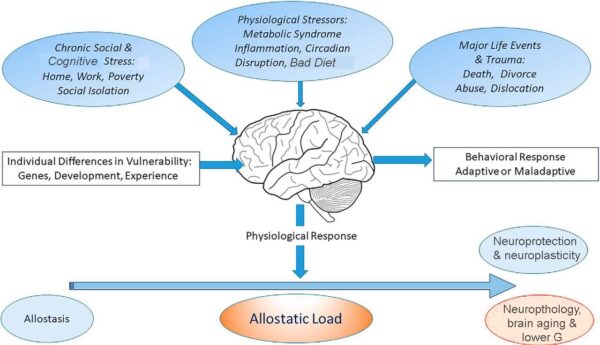
But the paradigm changing idea that distinguishes allostasis from homeostasis is that it sees efficient physiological regulation as involving anticipation of needs and challenges, and the preparation of our physiology to match them before they arise. Rather than simply reacting to the environment, allostasis regulates metabolism, hormones, immune cells and neurotransmitters, in a predictive way – to proactively meet and recover from demands and challenges in advance, reducing ‘shocks’ to our system as it were.
A good example of allostasis-based BioQ many of us can relate to, connecting biology to intelligence, is found in the benefits of healthy and robust circadian cycles regulating sleep. Sleep is embedded in this 24-hour cycle and its timing, duration, and internal phases is regulated by the circadian pacemaker. Changes in lighting and other cues, melatonin and body temperature,, with the feeling of sleepiness, all initiate preparation for sleep, and sleep itself enables physiological rest and recovery, emotion processing, insight and memory consolidation. Disruptions in circadian sleep cycles increase stress-responsivity, and cause emotional distress; it also impairs attention, vigilance and working memory, long-term memory and decision-making.
Another example of a failure of allostasis is performance anxiety for a test, interview or competition, which can impair sleep as well as working memory and fluid intelligence, by inducing dysfunctional stress-related preparatory responses, instead of adaptive ones that meet the challenge with an appropriate physiological alertness and positive mindset. With more BioQ, you are less susceptible to disabling performance anxiety.
BioQ is understood within the IQ-EQ-BioQ framework not only in terms of adaptive allostasis, but also in terms of aerobic fitness and nutrition, relating to the essential building blocks of brain-based cognition, and associated mitochondrial and ATP-dependent capacities to produce and utilize energy for motivated action, and have a ready supply of amino acids, hormones, peptides and neurotransmitters for neuroprotection and neuroplasticity. If Carl Friedrich Gauss, the genius German mathematician and physicist back in the 19th century, had chronic insomnia, was deficient in essential nutrients and could barely walk up the stairs without losing his breath, he would likely have made significantly fewer contributions to mathematics and science!
BioQ, like EQ and IQ, is an essential dimension of your adaptive general intelligence (G).
Gx – Smart Institutional, Technological, Cultural & Social Infrastructure
Gx encompasses all the ‘intelligent designs’ that we are embedded in in our environment – our cognitive niche. This includes our social networks, the technologies we use, how we organise our information externally, what apps we use regularly, the institutions we work in, and the culture we are a part of.
There is a hidden two-way causation between our cognitive abilities and our environments – and over time our intelligence is a function of both. High G individuals will be in more enriched, cognitively stimulating environments, such as stimulating and supportive friendship groups or families, pro-education cultural attitudes and challenging careers, institutions and hobbies that stretch them intellectually. This is in part because, over time, choices sculpt environments to match (and open opportunities for) cognitive abilities, and more intellectually challenging environments, in turn, exercise and augment cognitive abilities. This positive feedback loop is what Dickens and Flynn (of ‘Flynn Effect fame) call the multiplier effect. It is analogous to a kind of ‘law of attraction’. Small initial differences in G, or differences in socio-cultural opportunity, can magnify quickly over time through ongoing IQ-environment feedback loops into very large IQ differences.
Dickens and Flynn use an analogy from basketball, to explain how the multiplier effect works. You can see the important role EQ plays in the process.
A father who loves basketball and who has a son with slightly better than average genes for the relevant physical traits is likely to play basketball with his son at an early age, and they are likely to play together more often than most. The son may become a bit better at basketball than others his age and may frequently be an early pick when teams are chosen in the school yard. This makes him feel good, so he begins to prefer basketball to other sports. The extra practice makes him better still, and the better he gets, the more he enjoys basketball. He is far more likely than most to be singled out for membership on a school or recreational team where he will receive expert coaching. Such a young person is likely to become a very good basketball player—much better than he would be if his only distinction was the minor physical and social advantages posited at the outset.
The initial difference in ability can be both genetic or cultural. In this example, the trigger could have been the boy’s basketball-loving father, or the local basketball facilities, or a particular friendship group. Anything that is reinforcing to someone and gives an advantage can improve skills and ability, and foster motivations and choices that further improve the environment, that further improves ability, and so on over the years in what may become a powerful multiplier effect.
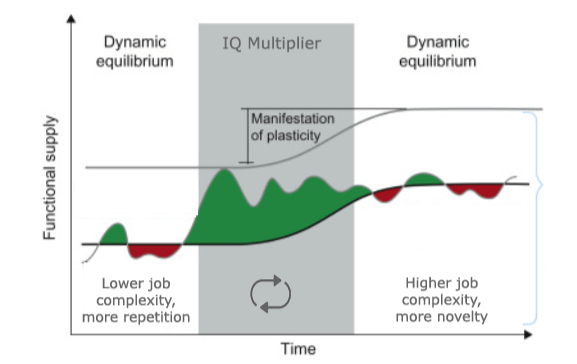
Within the IQ-EQ-BioQ framework, Gx – or extended intelligence – is what sustains your ability-environment multiplier effect. Gx is distributed intelligence. It increasingly integrates new technologies and apps, computational networks, and artificial intelligence. It combines both a supporting ‘smart culture’ and the opportunities it offers you, as well as your history of choices that sculpt the cognitive niches you think, work and play in – to further augment your IQ, EQ and BioQ.
In summary, this EQ-IQ-BioQ and Gx framework is ‘next level’ understanding of general intelligence that provides the conceptual map underlying the apps, programs and coaching we offer at IQ Mindware, and the direction the R&D takes in my cloud-based Health, Resilience and Performance (HRP) Lab.
You can find a model of the complex neurobiological basis of IQ, EQ and BioQ in Appendix 2.
It’s my sincere hope that you feel this conceptual map has been of use to you and that it consolidates in your cortex over time.
IQ-EQ-BioQ References
Framing Effects
Keren, G. (2011). On the definition and possible underpinnings of framing effects: A brief review and a critical evaluation. In G. Keren (Ed.), Perspectives on framing (pp. 3–33). Psychology Press.
General definitions of intelligence
Gottfredson, L. S. (1997). Mainstream science on intelligence: An editorial with 52 signatories, history and bibliography [Editorial]. Intelligence, 24(1), 13–23. https://doi.org/10.1016/S0160-2896(97)90011-8
Neisser, U., Boodoo, G., Bouchard, T. J., Jr., Boykin, A. W., Brody, N., Ceci, S. J., Halpern, D. F., Loehlin, J. C., Perloff, R., Sternberg, R. J., & Urbina, S. (1996). Intelligence: Knowns and unknowns. American Psychologist, 51(2), 77–101. https://doi.org/10.1037/0003-066X.51.2.77
Legg, S., & Hutter, M. (2007). A Collection of Definitions of Intelligence. ArXiv:0706.3639 [Cs]. http://arxiv.org/abs/0706.3639
IQ – fluid and crystallized intelligence
Brown, R. E. (2016). Hebb and Cattell: The Genesis of the Theory of Fluid and Crystallized Intelligence. Frontiers in Human Neuroscience, 10. https://www.frontiersin.org/article/10.3389/fnhum.2016.00606
EQ – emotional intelligence and self-regulation
Peña-Sarrionandia, A., Mikolajczak, M., & Gross, J. J. (2015). Integrating emotion regulation and emotional intelligence traditions: A meta-analysis. Frontiers in Psychology, 6, 160. https://doi.org/10.3389/fpsyg.2015.00160
BioQ – biological intelligence
Sterling, P.; Eyer, J. (1988). “Allostasis: A new paradigm to explain arousal pathology”. In Fisher, S.; Reason, J. T. (eds.). Handbook of life stress, cognition, and health. Chicester, NY: Wiley. ISBN 9780471912699. OCLC 17234042.
Sterling, Peter (April 2012). “Allostasis: A model of predictive regulation”. Physiology & Behavior. 106 (1): 5–15. doi:10.1016/j.physbeh.2011.06.004.
Gx: The Multiplier Effect
Dickens, W. T., & Flynn, J. R. (2001). Heritability estimates versus large environmental effects: The IQ paradox resolved. Psychological Review, 108(2), 346–369. https://doi.org/10.1037/0033-295X.108.2.346
Lövdén, M., Bäckman, L., Lindenberger, U., Schaefer, S., & Schmiedek, F. (2010). A theoretical framework for the study of adult cognitive plasticity. Psychological Bulletin, 136(4), 659–676. https://doi.org/10.1037/a0020080
Appendix 1: Gf and Gc Test Items
When you are tested on reasoning such as with matrices tests where you have to complete the figure series (see below), it’s Gf that’s the cognitive ability of interest.
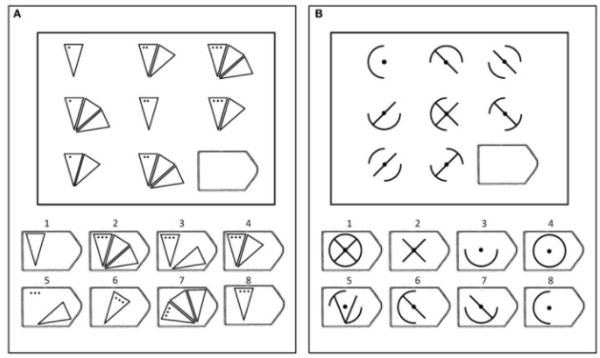
When you are tested on language ability such as vocabulary, general knowledge or language comprehension such as filling in the gaps in the C-Test (below), it’s Gc that’s the cognitive ability of interest.

Appendix 2: A Cognitive Neuroscience IQ-EQ-BioQ Model
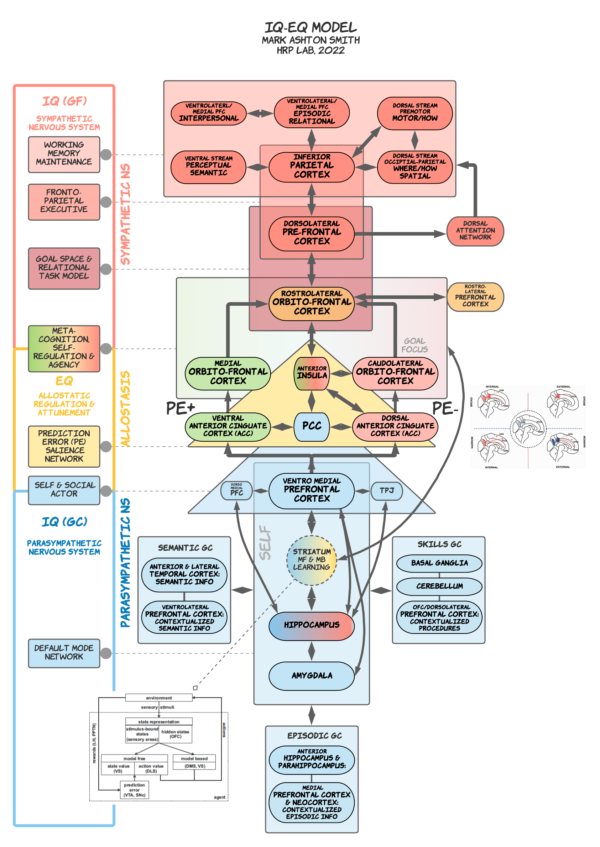
[/vc_column_text][/vc_column][/vc_row]